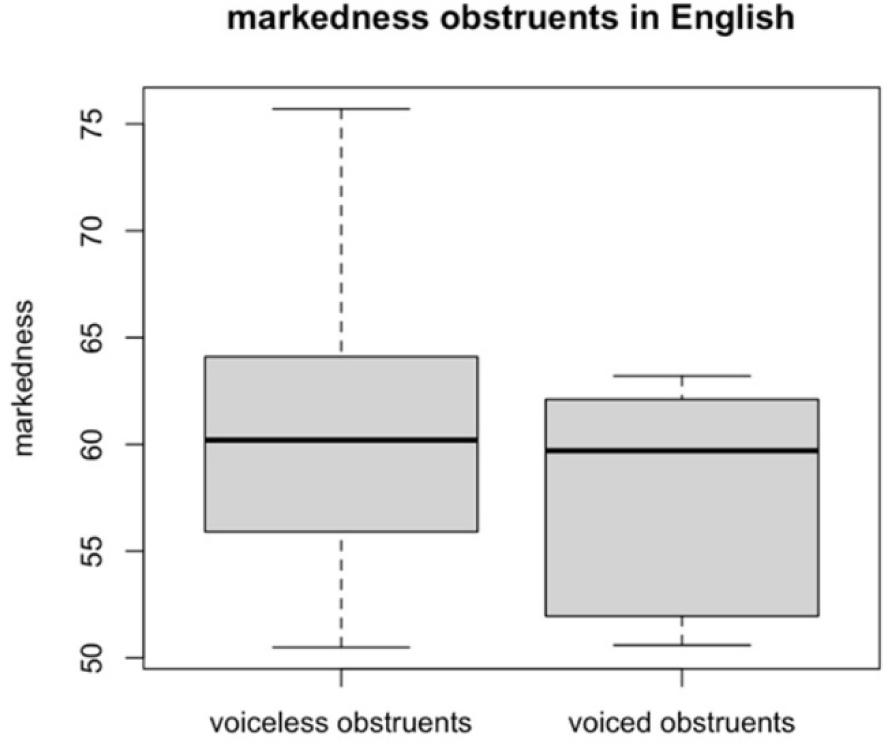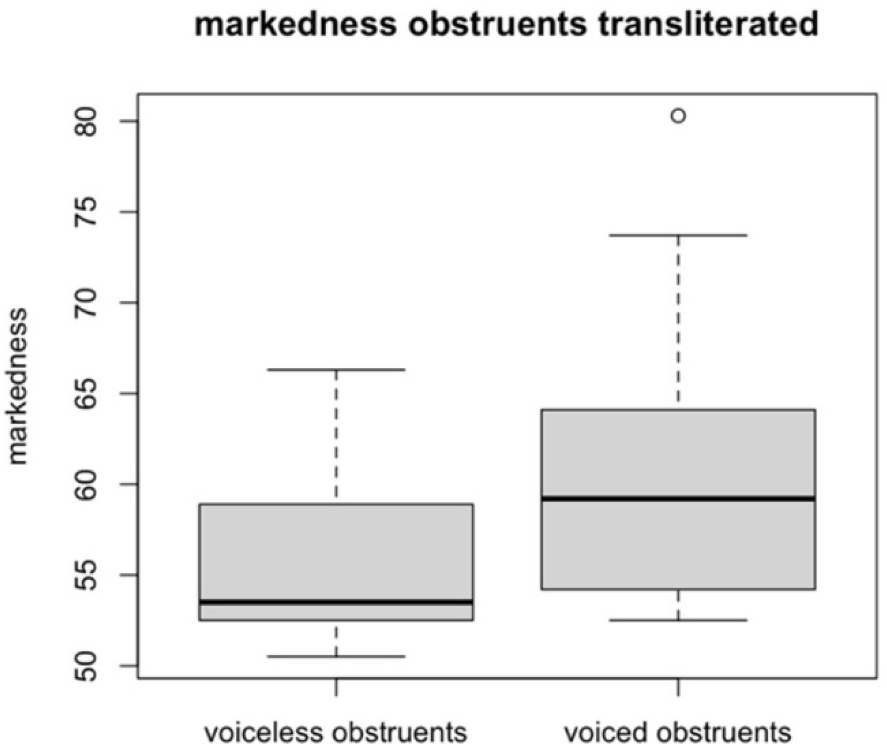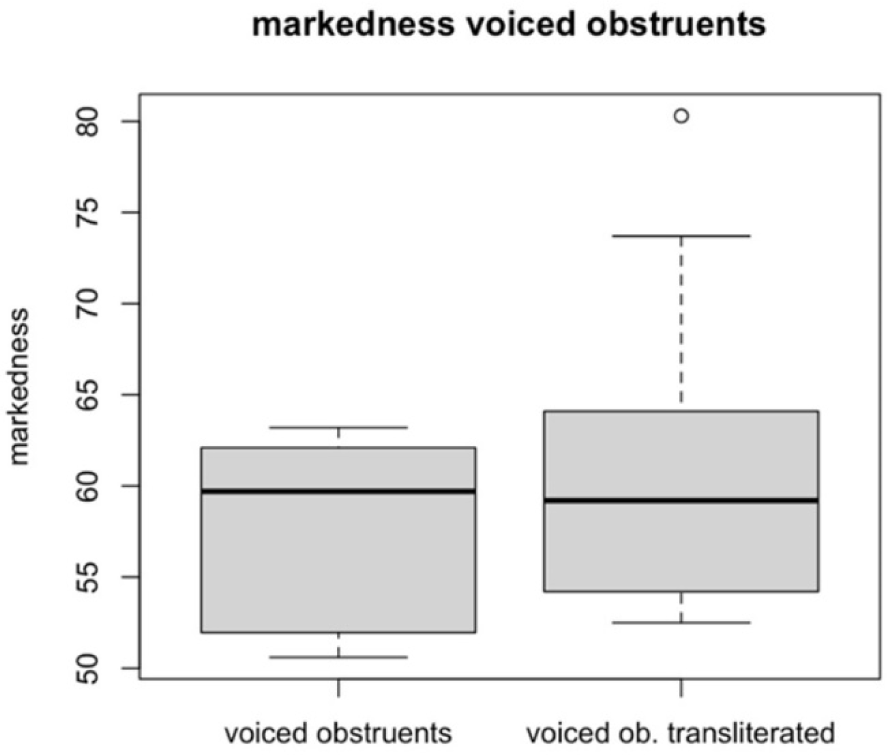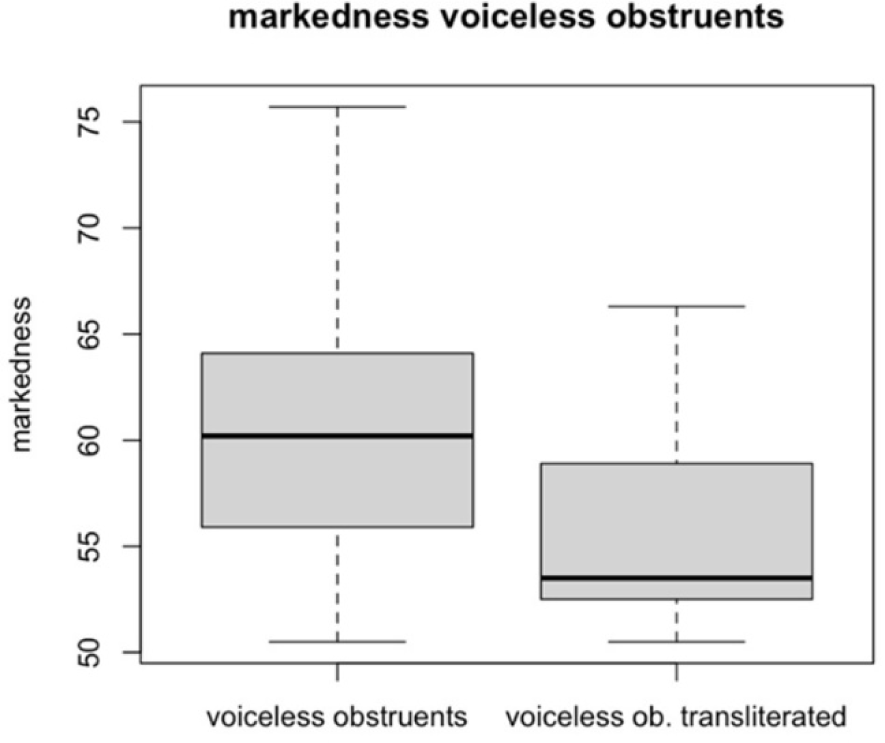1. Introduction
Due to globalization as a prime impetus, companies need analytical research for their global marketing strategies. Many factors exist that influence a company’s strategies and decisions when entering a new or foreign market such as the visual appeal of products or cultural implications. In recent years an aggrandized interest is shown in auditive characteristics as part of sound and sonic branding, including slogans or jingles (Graakjær & Jantzen 2009). Among these, a large number of articles encompass brand names (Yorkston & Menon 2004). Several studies investigate the conjunction between certain linguistical markers such as syllabic length and structure, quality of vowel or type of consonant, and a perceived psycholinguistic quality like trustworthiness or sharpness in a brand name (Klink 2000, Joshi et al. 2014). The research, done by Pathak et al. (2020) investigates the link between obstruents (voiced and voiceless) and a perceived harshness of the brand name. The study done by Pathak et al. (2020) ascertains a link between voiced obstruents and a perceived harshness in English brand names as well as voiceless obstruents and a perceived softness (lack of harshness).
However, many sound branding studies lack cross-linguistical and/or cross-cultural validation (Shrum et al. 2012). That raises the question of whether an observed cohesion between certain linguistical markers and product perception is universally applicable since most studies are based on product names in English. For instance, if voiced obstruents are linked with perceived harshness of a product name, will that product still be identified as harsh sounding in a language that does not contain voiced obstruents, e.g., in Korean?
Based on the work done by Pathak et al. (2020), this paper will show that in contrast to native English speakers, products that contain voiceless obstruents in English will be perceived as harsh sounding, and products containing voiced obstruents in their brand name as predominantly soft. It will also be shown that the markedness of perceived harshness will decrease when the product name is transliterated.
2. Theoretical Background
Although every natural language consists of both vowels and consonants (Ladefoged & Disner 2012) and all languages instantiate a consonant/vowel contrast (Nazzi & Cutler 2019), vowels and consonants differ in their perceptibility. Furthermore, vowels and consonants differentiate in their roles. Vowels carry prosodic information like vowel harmony and pitch changes by which they may convey facets of syntactic structure. In contrast, consonants bear lexical information (Toro et al. 2008). That categorical distinction and individual representation of vowels and consonants (Goldsmith 1976) suggests a contingency that vowels and consonants have different effects regarding sound branding. Consonants are sounds produced by obstruction of the oral cavity in the process of articulating. Consonants can be divided into bilabial, labiodental, dental, alveolar, postalveolar, alveolo-palatal, retroflex, palatal, velar, uvular, pharyngeal, or glottal; depending on the point of articulation (Shin 2012). They can also be classed by the manner of articulating into stops, fricatives, affricates, nasals, and liquids (Shin 2015). Stops, fricatives, and affricatives constitute the obstruents.
Chomsky & Halle (1968) define obstruents in contrast to sonorants. While “Sonorants are sounds produced with a vocal tract cavity configuration in which spontaneous voicing is possible; Obstruents are produced with a cavity configuration that makes spontaneous voicing impossible.” (Hall & Żygis 2010).
In English, among others, obstruents can further be segmented into voiced obstruents and voiceless obstruents. In English voiced stops (k, p, t), voiceless stops (g, b, d), voiced fricatives (s, ʃ, θ, f), voiceless fricatives (z, ʒ, ð, v), as well as affricatives (tʃ & dʒ), can be found (Pathak et al. 2020). It is further suggested that the perception of voiced obstruents is harsher than that of voiceless obstruents. As a possible explanation, the FCH1 is suggested.
Based on the work done by Ohala (1994) the FCH tries to relate frequencies to body size. More precisely it was observed, that in the animal kingdom bodies of a larger extent vocalize with a lower frequency, while smaller bodies vocalize at a higher frequency. It is then inferred that humans will associate lower frequencies with larger bodies and vice versa. Furthermore, it is argued that threats and danger are associated with lower frequencies while higher frequencies with harmlessness (Fitch 1997). Since voiced obstruents are believed to be articulated at a lower frequency (Kingston & Diehl 1995, Kingston et al. 2008), it would illustrate a cohesion between voiced obstruents and harshness as well as voiceless obstruents with a certain softness (lack of harshness) as suggested by Pathak et al. (2020).
If a certain universality is to be assumed, we ought to find similar results, by conducting similar experiments in a different linguistical setting. However, as it will be shown, brand names, which constitute voiceless obstruents are associated with harshness by native Korean speakers rather than softness. The FCH fails to account for a sufficient explanation. The reasons for that are eclectic. For instance, Pitch (and therefore frequency) have different meanings or rather associations in context of sound symbolism (Winter et al. 2021). High frequency is not only associated with smaller bodies, but also with triangular shapes (O’Boyle & Tarte 1980), which impedes an unequivocal explanation. Meaning, that there is no par-for-par connection between pitch and its association. In addition, harmlessness and politeness are used contiguously in the context of the FCH, explaining why Japanese females use higher pitch when using polite speech (Loveday 1981, Ohara 2001). However, it was found that Korean speakers lower their average voice pitch when speaking politely (Shin 2005; Winter & Grawunder 2011, 2012); directly contradicting the FCH.
Likewise, when looking for a relation between voiced/voiceless obstruents and harshness/lack of harshness is the conjuncture, that not every language produces voiced obstruents. Even though generally consonants could be divided into voicing and aspirations, it is more difficult in the case of the Korean language. Whilst The Korean language contains stops and affricatives, they are all phonemically voiceless (Hyman 1975, Shin 2012). That raises the question when presented with English brand names consisting of voiced obstruents, how will native speakers of the Korean language conceive these in the context of sound branding?
3. Method
This research implemented three separate studies. Firstly, twenty-one HBN containing voiced obstruents (/b/, /d/, /g/, /z/, and /v/) and twenty-one HBN containing voiceless obstruents (/p/, /t/, /k/, /s/, and /f/) had been shown to native Korean speakers in English. The HBNs, identic to the work done by Pathak et al. (2020) were trisyllabic, with a CV-CV-CV (consonant-vowel) structure. A second group was shown the same brand names but transliterated. The transliteration was realized by a native Korean speaker. Lastly, the same HBN in English had been presented to a small control group consisting of native English speakers. The research was conducted in a controlled environment at Chosun University in Gwangju, South Korea. Every participant, who had been invited to participate in the experiment was compensated for their time and effort. The study intends to audit the association of certain obstruents with harshness (or softness) of English Brand names in Korean.
Seventy-seven participants conducted the first experiment (agemax: 44 years, agemin: 20 years, agemean: 26.584, SD: 6.536, female: 40, male: 37). All participants were native Korean speakers with a vestigial knowledge of English. Since English is broadly taught in schools, it is almost impossible to find experiment participants, who do not know at all about the English language.
Participants were presented with twenty-one HBNs containing voiced obstruents and twenty-one HBNs containing voiceless obstruents. See appendix; Table A1. After being told that a foreign company is releasing two new products on the Korean market, one being a toilet cleaning product and the other being a skin lotion product, the participants were asked to allocate potential product names to one of the two products. Subsequently, one of forty-two HBNs were shown on a computer screen and the respondents were asked to drag the product name to the product category they deemed most fitting. The motion of dragging the product name has been rehearsed beforehand and the sequence of HBNs had been randomized. The HBNs were presented in English. In addition, after choosing one product category, the participants were asked to rate the degree of fitness of the HBNs to the product category. To that end, the participants were asked to drag a slider between zero and one hundred to rate the aptness of the product name.
In total, fifty-six participants conducted the second experiment (agemax: 46 years, agemin: 21 years, agemean: 27.25, SD: 6.025, female: 34, male: 22). All respondents were Korean native speakers with tenuous knowledge of the English language.
Whereas the first experiment examines whether a certain psycholinguistic effect due to specific grammatical markers is cross-cultural tenable. The second experiment aims to investigate whether a writing system, in which the product brand names are represented may influence brand perception.
Akin to the first study, twenty-one HBNs containing voiced obstruents and twenty-one HBNs containing voiceless obstruents were shown to the participants. See appendix; Table A2. However, the HBNs were transliterated by a Korean native speaker beforehand and were presented in the Korean alphabet (Hangeul). Otherwise, the set-up of the second experiment complies with the set-up of the first experiment.
A small control group consisting of 20 native English speakers performed the third experiment (agemax: 37 years, agemin: 26 years, agemean: 31.25, SD: 2.971, female: 10, male:10). The control group had been presented with the same twenty-one HBN as the first experimental group. The results of the control group reflect at large the results of the paper done by Pathak et al. (2020) and will be discussed explicitly in the next chapter.
4. Results
Out of twenty-one HBNs, containing voiced obstruents sixteen HBNs had been unequivocally identified as suitable for toilet cleaning products, whereas seventeen out of twenty-one HBNs containing voiceless obstruents had been unequivocally identified as suitable for skin lotion products by the control group. This finding suggests a strong connection between voiced obstruents and harshness and corroborates the results of the work done by Pathak et al. (2020).
However, being shown the same HBNs containing voiced and voiceless obstruents in the first study, participants identified invariably every single HBN containing voiceless obstruents as suitable for toilet cleaning products. In addition, sixteen HBNs consisting of voiced obstruents were identified as suitable for skin lotion products.
Being asked to assess the degree of fitness (the unambiguity of affinity to the chosen group, which will be called markedness henceforth), HBNs composed of voiceless obstruents had been showing slightly higher suitableness for toilet cleaning products (Figure 1) than HBNs composed of voiced obstruents to skin lotion. Meaning the participants had been more assertive with their decision for voiceless obstruents.

When the brand names had been transliterated eighteen of the twenty-one HBNs containing voiceless obstruents were identified as suitable for toilet cleaning products. Out of twenty-one HBNs originally containing voiced obstruents fourteen HBNs had been deemed suitable for skin lotion products. In contrast to the first study, HBNs with voiced obstruents show higher markedness than HBNs with voiceless obstruents as shown in Figure 2.

When comparing the markedness of HBNs composed of voiced obstruents, no big difference is shown between HBNs presented in English and HBNs transliterated (Figure 3).

However, when comparing the markedness of voiceless obstruents, the aptness to the product name (skin lotion) is seen higher when presented in Hangeul rather than transliterated (Figure 4).

5. Discussion
Product acceptance is imperative in selling a product. It is well-established that brand names have a major influence on product acceptance (Charmasson 1988). By Olson (1974) brand names are counted to the extrinsic cues that refer to product quality to potential customers. These include mere pronounceability of product names (Irmak et al. 2011). Positive product reception can also be achieved by semantic association. However, studies of sound symbolism have shown that perception of various product attributes can be elicited by different sounds (Abel & Glinert 2008, Krishna 2012, Parise & Spence 2012, Spence 2012). Pathak et al. (2020) argue that most of these studies are focused on vowels rather than consonants. It could be argued that this is contingent upon the fact that vowels, in general, are longer, and stressed vowels resist better noise-making (Nooteboom & Doodeman 1984). That would suggest that vowels are more useful in lexical activation, albeit the opposite is true (Van Ooijen 1996). That punctuates the need for more studies focused on consonants. The work done by Pathak et al. (2020) undoubtedly constitutes a great contribution in that regard. However, this article and its experiment show that a putative universality is not given or needs yet to be proven.
An explanation of the difference in perception of voiceless obstruents has still yet to be made. While voiceless obstruents had been perceived as less harsh and therefore more suitable for products like skin lotion by English speakers, voiceless obstruents were perceived invariably as harsh sounding. A potential explanation will be the VOT suggested. It was observed that with a decrease of the VOT in voiceless production in English, the f0 increases (McCrea & Morris 2005, Narayan & Bowden 2013, Groll et al. 2021). That is in line, with the previous suggestion of FCH. However, in cross-linguistical studies it was suggested, that VOTs were shorter in English than in Korean (Kim 2021, Oh 2021), which could influence the perception of harshness and f0. Further studies on that subject will be necessary.
However, it was also noticed, that the perception of a product name can be influenced by the transcription of said product name. Although it needs to be invested further, one reason could be that Korean and Hangul has a one-to-one correspondence between letters and phonemes, whereas English is not as perspicuously in correspondence between letters and phonemes. Furthermore, the revised hierarchical model may also offer an explanation to some degree since the elaborate conceptional link to the participant’s first language (L1) facilitated more intense processing than L2 (Ahn & La Ferle 2008).
Also reading an unknown product name, which is presented in English, presupposes the capability to analyze and process linguistic markers of a foreign language (Goodman 1968, Carrell & Eisterhold 1983, Barnett 1986, Hammadou 1991). An important factor, that affects the deconstruction and construction of meaning is context (Carrell & Eisterhold 1983). Participants were given nonsensical words, which exacerbate the participants to interfere meaning of the brand names and ultimately could have led to found differences. Participants could not process the HBNs in a conceptually driven way but rather in a data-driven way (Roediger 1990).
This article might suggest that different research for different sales markets for different products in the context of sound branding is still seemingly a necessary endeavor for companies to determine new product names. A process that can already be found e.g., Coca-Cola in China as pointed out by Pathak et al. (Fetscherin et al. 2012). However, that is only partly true. For a brand name and consequently the brand itself to be successful, certain criteria must be fulfilled. For instance, brand names ought to be easily distinguishable (Klinik 2001). Furthermore, a brand name should not become too hard to pronounce or even ineffable (Klinik 2001). That’s why it can be found that certain consonants and vowels are preferred (Pogacar et al. 2018). In turn, uncommon vowels or consonants should be avoided. Given that “all languages have voiceless obstruents and voiced sonorants” (Major & Faudree 1996), voiced obstruents should be avoided when creating a brand name. The results as discussed in chapter 4 would corroborate this notion. Given that “only” 16 out of 21 HBNs (72.2%) containing voiced obstruents had been conclusively linked to a perception in the context of sound symbolism, while the relation between voiceless obstruents to a sound symbolistic perception had been bijective. That means companies are encouraged to favor voiceless obstruents when creating a brand name.
Additionally, it should be pointed out, that the occurrence of a sound symbolism effect when observing brand names seems to be to some degree universal. Meaning, that no study regarding sound symbolism and brand names had yet been inconclusive or no effect of sound branding had occurred. In the context of modern linguistic theories, the arbitrariness of signs—mainly motivated by De Saussure (1916)—had been most dominating. Assumed sound symbolistic patterns originated in their phonetic traits, sound symbolism, and as a result sound branding, are likely to be universal. If this is the case, this article may subscribe to the question, what degree of abstraction is prerequisite to compile universality?
6. Limitation
To be able to adequately contrast the two studies, brand names, suggested by the study by Pathak et al. (2020) had been used. The brand names had been comprised of trisyllabic nature following a CV-CV-CV structure. As pointed out by Pathak et al. (2020), a different structural set-up and/or different syllabic lengths may influence the results. Furthermore, a subsequent study is proposed to differentiate the perceived effects of obstruents portioned by obstruents type. These perceived notions may differentiate by stops, fricatives, or affricatives.
More importantly, a further study is suggested, in which brand names are not perceived through the notion of reading but rather auditorily. It is conceivable that there is a difference in perception of brand names through different means of mediums and gender-based differences. Human vocalizations are characterized by sexual dysmorphism. Meaning that the f0 of female speakers is on average 70% higher than that of male speakers (Klatt & Klatt 1990).
